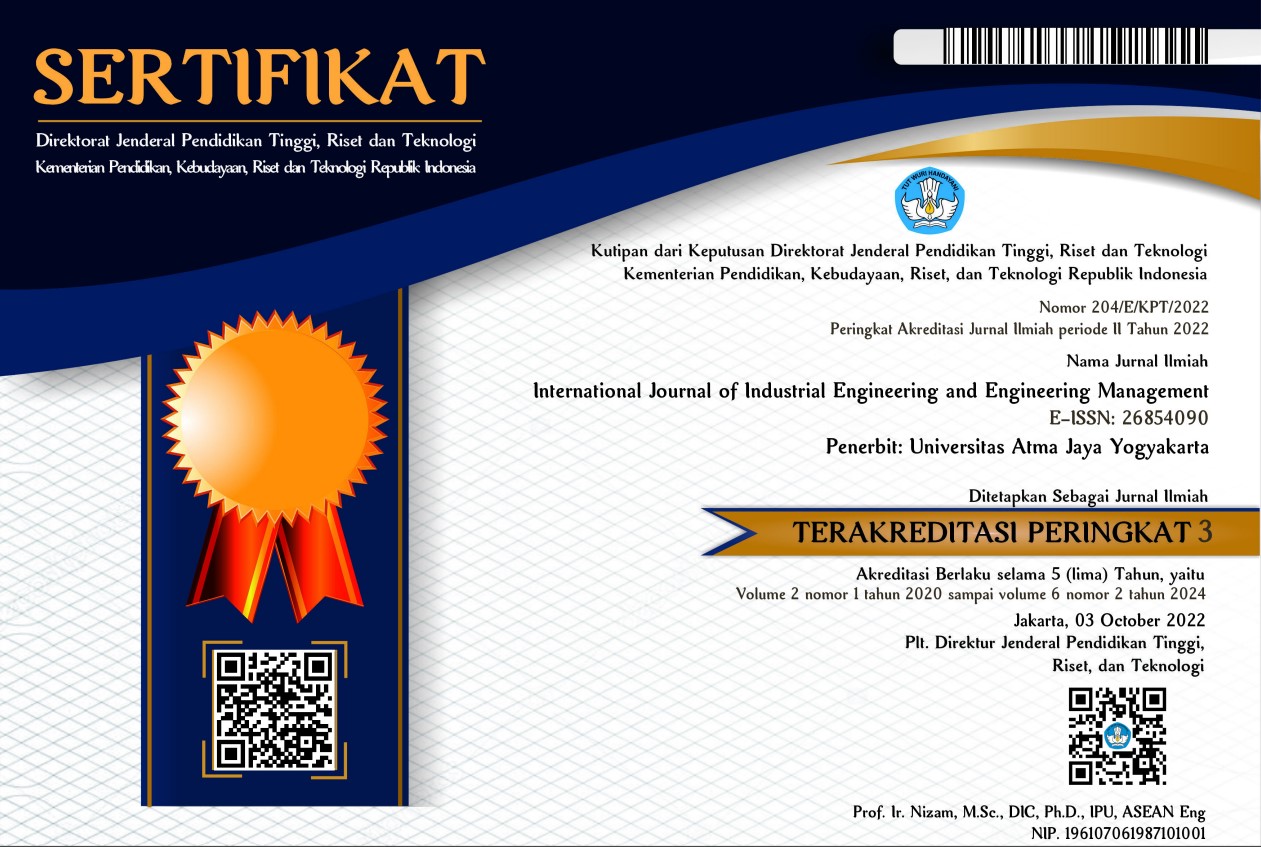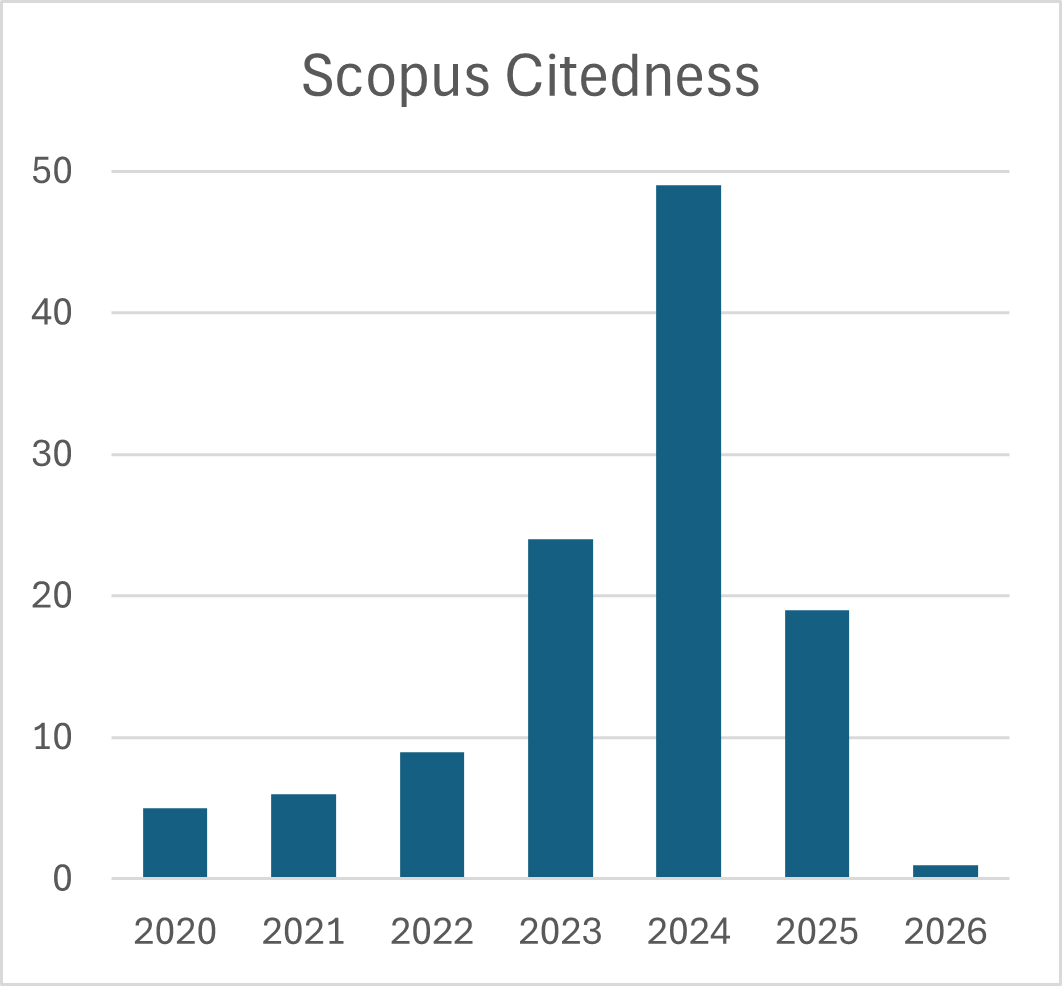Novel EDAS-Taguchi and EDAS-Taguchi-Pareto Methods for Wire EDM Process Parametric Selection of Ni55.8Ti (Nitinol) Shape Memory Alloy
DOI:
https://doi.org/10.24002/ijieem.v3i2.4998Keywords:
Nitinol, electrical discharge machining, multicriteria method, optimum selectionAbstract
The EDAS (evaluation based on distance from average solution) method is a broadly utilized tool for multi-criteria analysis with the ability to handle several conflicting criteria. The Taguchi method is an optimization tool with economic capability in experimentation. This article presents EDAS Taguchi (EDAS-T) method based on EDAS and the Taguchi method. It also presents EDAS Taguchi-Pareto (EDAS-TP) method framed from EDAS and Taguchi-Pareto methods. Furthermore, data from the literature to test the proposed methods are presented, which the results are compared. This research shows that the EDAS method produces the optimum combination of parameters at a run with a current of 4A, pulse on time of 50 µs, pulse off time of 14ms, and powder concentration of 1 g/L. Also, the EDAS-Taguchi method reveals a current of 4A, pulse on time of 60 µs, pulse off time of 14 µs, and powder concentration of 1 g/L. However, the principal result is that using the EDAS Taguchi-Pareto method, the optimal current is 3A, pulse on time is 60 µs, and powder concentration is 0.75g/L. The EDAS Taguchi-Pareto method eliminated the pulse off time and pulse on time, claiming that it is not significant to the system's optimum performance. The principal novelty of this article is that it introduces a mechanism of concurrently optimizing and selecting the wire EDM process parameters using the EDAS-Taguchi-Pareto method. The optimization is parallelly conducted as selection occurs, providing an initial notification to ascertain timely detection and control of local optimality of parameters to global optimization before final selection. This is unlike most evaluations, where optimization is done differently from the selection. This study is the first to develop and use EDAS methods for the WEDM process of Ni55.8Ti shape memory alloy.
References
Chakala, N., Chandrabose, P.S., & Rao, C.S.P. (2019). Optimisation of WEDM parameters on nitinol alloy using RSM and desirability approach. Australian Journal of Mechanical Engineering, 19(5), 1-13.
Chaudhari, R., Vora J., López de Lacalle, L.N., Khanna, S., Patel, V.K., & Ayesta, I. (2021a). Parametric optimization and effect of nano-graphene mixed dielectric fluid on performance of wire electrical discharge machining process of Ni55.8Ti shape memory alloy. Materials, 14, Article 2533.
Chaudhari, R., Khanna, S., Vora, J., Patel, V.K., Paneliya, S., Pimenov, D.Y., Giasin, K., & Wojciechowski, S. (2021b). Experimental investigations and optimization of MWCNTs-mixed WEDM process parameters of nitinol shape memory alloy. Journal of Materials Research and Technology, 15, 2152-2169.
Das, P.P. & Chakraborty, S. (2020). Application of grey correlation-based EDAS method for parametric optimization of non-traditional machining processes. Scientia Iranica, Article in Press.
Davis, R., Singh, A., Debnath, K., Sabino, R.M., Popat, K., Silva, L.R.R., Soares, P., & Machado, Á. R. (2021). Surface modification of medical-grade Ni55.6Ti44.4 alloy via enhanced machining characteristics of Zn powder mixed-μ-EDM. Surface and Coatings Technology, 425, Article 127725.
Fu, C.H., Liu, J.F., Guo, Y.B., & Zhao, Q.Z. (2016). A comparative study on white layer properties by laser cutting vs. electrical discharge machining of nitinol shape memory alloy. Procedia CIRP, 42, 246-251.
Guo, Y., Klink, A., Fu, C., & Snyder, J. (2013). Machinability and surface integrity of nitinol shape memory alloy. CIRP Annals, 62(1), 83-86.
He, Y., Lei, F., Weif, G., Wang, R., Wu, J., & Wei, C. (2019). EDAS method for multiple attribute group decision making with probabilistic uncertain linguistic information and its application to green supplier selection. International Journal of Computational Intelligence System, 12(2), 1361-1370.
Keshavarz-Ghorabaee, M., Zavadskas, E.K., Olfat, L., & Turskis, Z. (2015). Multi-criteria inventory classification using a new method of evaluation based on distance from average solution (EDAS). Informatica, 26(3), 435-451.
Krishankumar, R., Pamucar, D., Deveci, M, & Ravichandran, K.S. (2021). Prioritization of zero-carbon measures for sustainable urban mobility using integrated double hierarchy decision framework and EDAS approach. Science of the Total Environment, 797, Article 149068.
Kulkarni, V.N., Gaitonde, V.N., Aiholi, V., & Hadimani, V. (2018). Multi performance characteristics optimization in wire electric discharge machining of Nitinol superelastic alloy. Materials Today: Proceedings, 5(9), 18857-18866.
Liu, J.F., Li, L., & Guo, Y.B. (2014). Surface integrity evolution from main cut to finish trim cut in w-EDM of shape memory alloy. Procedia CIRP, 13, 137-142.
Liu, J.F., Li, C., Fang, X.Y., Jordon, J.B. & Guo, Y.B. (2018). Effect of wire-EDM on fatigue of nitinol shape memory alloy. Materials and Manufacturing Processes, 33(16), 1809-1814.
Majumder, H. & Maity, K. (2018). Prediction and optimization of surface roughness and micro-hardness using GRNN and MOORA-fuzzy-a MCDM approach for Nitinol in WEDM. Measurement, 118, 1-13.
Markets and Markets. 2021. Market Research Report, Report Codech 6263, 230p.
Mwangi, J.W., Bui, V.D., Thüsing, K., Hahn, S., Wagne,r M.F.-X., & Schubert, A. (2020). Characterization of the arcing phenomenon in micro-EDM and its effect on key mechanical properties of medical-grade Nitinol. Journal of Materials Processing Technology, 275, Article 116334.
Naresh, C., Bose, P.S.C., & Rao, C.S.P. (2020). ANFIS based predictive model for wire EDM responses involving material removal rate and surface roughness of Nitinol alloy. Materials Today: Proceedings, 33(1), 93-101.
Okponyia, K.O. & Oke, S.A. (2020). Exploring aluminium alloy metal matrix composites in EDM using coupled factor-level-present worth analysis and fuzzy analytic hierarchy process. International Journal of Industrial Engineering and Engineering Management, 2(1), 25-44.
Rashid, T., Ali, A., & Chu, Y.M. (2021). Hybrid BW-EDAS MCDM methodology for optimal industrial robot selection. PLoSOne, 16(2), Article 0246738.
Roy, B.K. & Mandal, A. (2019). Surface integrity analysis of Nitinol-60 shape memory alloy in WEDM. Materials and Manufacturing Processes, 34(10), 1091-1102.
Roy, B.K., Kumar, A., Sahu, D.R., & Mandal, A. (2020). Wire electrical discharge machining characteristics of nitinol-60 shape memory alloy. Materials Today: Proceedings, 22(4), 2860-2869.
Shaaban, S.M. & Abd, E.A.M. (2020). Integration of evaluation distance from average solution approach with information entropy weight for diesel engine parameter optimization. International Journal of Intelligent Engineering and Sytems, 13(3), 101-111.
Siqi, Z. Hui, G., Guiwu, W., Yu, W., & Cun, W. (2019). Evaluation based on distance from average solution method for multi-criteria group decision making under picture 2-Inpie Linguistic environment. Mathematics, 7(243), 1-14.
Trung, DOD. (2021). Application of EDAS, MARCOS, TOPSIS, MOORA and PIV methods for multi-criteria decision making in milling process. Journal of Mechanical Engineering, 71(2), 69-84.
Downloads
Published
How to Cite
Issue
Section
License
Copyright (c) 2021 International Journal of Industrial Engineering and Engineering Management

This work is licensed under a Creative Commons Attribution 4.0 International License.








